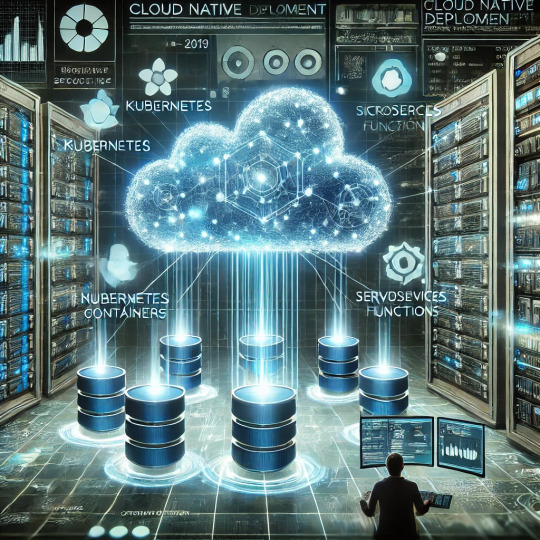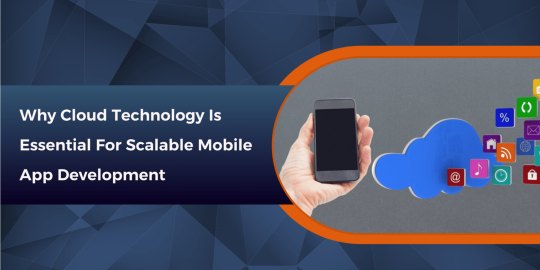#Cloud-native architecture
Explore tagged Tumblr posts
Text
Optimizing Applications with Cloud Native Deployment
Cloud-native deployment has revolutionized the way applications are built, deployed, and managed. By leveraging cloud-native technologies such as containerization, microservices, and DevOps automation, businesses can enhance application performance, scalability, and reliability. This article explores key strategies for optimizing applications through cloud-native deployment.

1. Adopting a Microservices Architecture
Traditional monolithic applications can become complex and difficult to scale. By adopting a microservices architecture, applications are broken down into smaller, independent services that can be deployed, updated, and scaled separately.
Key Benefits
Improved scalability and fault tolerance
Faster development cycles and deployments
Better resource utilization by scaling specific services as needed
Best Practices
Design microservices with clear boundaries using domain-driven design
Use lightweight communication protocols such as REST or gRPC
Implement service discovery and load balancing for better efficiency
2. Leveraging Containerization for Portability
Containers provide a consistent runtime environment across different cloud platforms, making deployment faster and more efficient. Using container orchestration tools like Kubernetes ensures seamless management of containerized applications.
Key Benefits
Portability across multiple cloud environments
Faster deployment and rollback capabilities
Efficient resource allocation and utilization
Best Practices
Use lightweight base images to improve security and performance
Automate container builds using CI/CD pipelines
Implement resource limits and quotas to prevent resource exhaustion
3. Automating Deployment with CI/CD Pipelines
Continuous Integration and Continuous Deployment (CI/CD) streamline application delivery by automating testing, building, and deployment processes. This ensures faster and more reliable releases.
Key Benefits
Reduces manual errors and deployment time
Enables faster feature rollouts
Improves overall software quality through automated testing
Best Practices
Use tools like Jenkins, GitHub Actions, or GitLab CI/CD
Implement blue-green deployments or canary releases for smooth rollouts
Automate rollback mechanisms to handle failed deployments
4. Ensuring High Availability with Load Balancing and Auto-scaling
To maintain application performance under varying workloads, implementing load balancing and auto-scaling is essential. Cloud providers offer built-in services for distributing traffic and adjusting resources dynamically.
Key Benefits
Ensures application availability during high traffic loads
Optimizes resource utilization and reduces costs
Minimizes downtime and improves fault tolerance
Best Practices
Use cloud-based load balancers such as AWS ELB, Azure Load Balancer, or Nginx
Implement Horizontal Pod Autoscaler (HPA) in Kubernetes for dynamic scaling
Distribute applications across multiple availability zones for resilience
5. Implementing Observability for Proactive Monitoring
Monitoring cloud-native applications is crucial for identifying performance bottlenecks and ensuring smooth operations. Observability tools provide real-time insights into application behavior.
Key Benefits
Early detection of issues before they impact users
Better decision-making through real-time performance metrics
Enhanced security and compliance monitoring
Best Practices
Use Prometheus and Grafana for monitoring and visualization
Implement centralized logging with Elasticsearch, Fluentd, and Kibana (EFK Stack)
Enable distributed tracing with OpenTelemetry to track requests across services
6. Strengthening Security in Cloud-Native Environments
Security must be integrated at every stage of the application lifecycle. By following DevSecOps practices, organizations can embed security into development and deployment processes.
Key Benefits
Prevents vulnerabilities and security breaches
Ensures compliance with industry regulations
Enhances application integrity and data protection
Best Practices
Scan container images for vulnerabilities before deployment
Enforce Role-Based Access Control (RBAC) to limit permissions
Encrypt sensitive data in transit and at rest
7. Optimizing Costs with Cloud-Native Strategies
Efficient cost management is essential for cloud-native applications. By optimizing resource usage and adopting cost-effective deployment models, organizations can reduce expenses without compromising performance.
Key Benefits
Lower infrastructure costs through auto-scaling
Improved cost transparency and budgeting
Better efficiency in cloud resource allocation
Best Practices
Use serverless computing for event-driven applications
Implement spot instances and reserved instances to save costs
Monitor cloud spending with FinOps practices and tools
Conclusion
Cloud-native deployment enables businesses to optimize applications for performance, scalability, and cost efficiency. By adopting microservices, leveraging containerization, automating deployments, and implementing robust monitoring and security measures, organizations can fully harness the benefits of cloud-native computing.
By following these best practices, businesses can accelerate innovation, improve application reliability, and stay competitive in a fast-evolving digital landscape. Now is the time to embrace cloud-native deployment and take your applications to the next level.
#Cloud-native applications#Cloud-native architecture#Cloud-native development#Cloud-native deployment
1 note
·
View note
Text










Forest (No. 82)
Mesa Verde National Park, CO
#Mesa Verde National Park#Montezuma County#USA#travel#original photography#vacation#tourist attraction#landmark#landscape#countryside#summer 2022#forest#woods#flora#nature#clouds#Colorado#Ancestral Puebloan#architecture#Native American history#US history#geology#archaeology#ruins#cliff
30 notes
·
View notes
Text
#AntStack TV#AntStack CEO & CTO Unplugged#Serverless Cloud Architecture#Generative AI in Development#Cloud-Native Ecosystems#Spotify
0 notes
Text
Securing Access at Machine Speed: Why SASE Is the Architecture for the AI Age
New Post has been published on https://thedigitalinsider.com/securing-access-at-machine-speed-why-sase-is-the-architecture-for-the-ai-age/
Securing Access at Machine Speed: Why SASE Is the Architecture for the AI Age


AI-powered adversaries have redefined what fast looks like. Credential stuffing at machine speed. Behavioral mimicry that defeats anomaly detection. And automated reconnaissance that probes VPNs and lateral movement paths without fatigue or friction. In this threat environment, traditional secure access models are no longer just outdated—they’re dangerous.
According to the 2025 State of Secure Network Access Report, 52% of cybersecurity professionals say remote connectivity is now the single hardest resource to secure. VPNs are breaking under the weight of hybrid work. SaaS and remote endpoints are slipping through fragmented security stacks. The perimeter has not only disappeared—it has dissolved into an unpredictable, cloud-native reality.
In this AI-fueled arms race, Secure Access Service Edge (SASE) isn’t just a security architecture. It’s the foundational control plane for defending the enterprise.
The Real Threat Isn’t Just Exposure — It’s AI-Accelerated Exploitation
Every modern breach involves abuse of access. Whether it’s a compromised VPN session, stolen OAuth token, or overly permissive SaaS role, attackers aren’t breaking in—they’re logging in. AI simply makes this process faster and harder to detect.
Machine learning models can now generate spear phishing payloads tailored to user roles. LLMs are used to write malware and obfuscate scripts. Compromised endpoints feed behavioral data back to attacker systems that refine their evasion tactics in real time.
And yet, most organizations still rely on static policies, brittle network controls, and legacy access methods. The result? An unguarded runway for AI-assisted lateral movement.
SASE: Designed for This Moment
SASE unifies SD-WAN, Zero Trust Network Access (ZTNA), Secure Web Gateway (SWG), Cloud Access Security Broker (CASB), and Firewall-as-a-Service (FWaaS) into a single, cloud-delivered fabric. It treats access not as a static configuration, but as a dynamic decision.
Every request is evaluated in real time. Who is the user? What device are they on? Where are they logging in from? Are they behaving like themselves? Based on this context, access is granted, challenged, or revoked instantly. This is how Zero Trust is enforced in practice—not just in posture decks.
SASE flips the model: users and apps no longer connect to the network. They connect to each other, through policy. And that policy is where your control resides.
Goodbye VPN: Legacy Access Is an Open Door
VPNs are the analog solution to a digital problem. They create flat network access, route traffic inefficiently, and rely on static credentials. They’re slow for users, opaque for defenders, and goldmines for attackers.
The report confirms it: over half of respondents say VPNs are their hardest access layer to secure. High latency. Poor visibility. Inconsistent enforcement. Worse, 42% of organizations say employees themselves are the highest risk group to business security—not outsiders. That’s a damning indictment of legacy access.
SASE eliminates the VPN choke point. Instead of tunneling everything back to a data center, users connect directly to the apps they need—through inspection points that enforce policy, detect anomalies, and block malicious behavior in real time.
AI on Your Side: SASE as Security Infrastructure for Machine Speed
AI threats require AI defenses. But AI can’t protect what it can’t see or control. That’s why SASE is more than just a security delivery model. It’s the infrastructure that enables intelligent, automated defense.
SASE platforms generate unified telemetry across users, devices, locations, apps, and behavior. This rich, normalized data set is what fuels AI-based detection models. It enables machine learning to find patterns, surface anomalies, and continuously optimize policy enforcement.
With SASE in place, you don’t just detect threats faster—you respond in real time. Contextual access controls can throttle bandwidth, trigger re-authentication, or isolate risky sessions automatically. Human responders focus on strategy, not fire drills.
The Choice Is Now: Fragmented or Future-Proof
SASE isn’t a trend. It’s an inevitability. The question is whether organizations adopt it on their terms—or after a breach forces their hand.
In an AI-dominated threat landscape, the winners will be those who design for machine-speed security. Unified visibility. Adaptive controls. Real-time enforcement. These are not future requirements. They are today’s minimums.
SASE makes them possible.
So the real question isn’t whether you can afford to deploy SASE.
It’s whether you can afford not to.
#2025#adversaries#ai#AI-powered#analog#anomalies#anomaly#anomaly detection#apps#architecture#attackers#authentication#Behavior#behavioral data#breach#Business#business security#CASB#Cloud#cloud-delivered#Cloud-Native#connectivity#credential#credential stuffing#credentials#cybersecurity#cybersecurity insiders#data#Data Center#defenders
0 notes
Text
Data Unbound: Embracing NoSQL & NewSQL for the Real-Time Era.
Sanjay Kumar Mohindroo Sanjay Kumar Mohindroo. skm.stayingalive.in Explore how NoSQL and NewSQL databases revolutionize data management by handling unstructured data, supporting distributed architectures, and enabling real-time analytics. In today’s digital-first landscape, businesses and institutions are under mounting pressure to process massive volumes of data with greater speed,…
#ACID compliance#CIO decision-making#cloud data platforms#cloud-native data systems#column-family databases#data strategy#data-driven applications#database modernization#digital transformation#distributed database architecture#document stores#enterprise database platforms#graph databases#horizontal scaling#hybrid data stack#in-memory processing#IT modernization#key-value databases#News#NewSQL databases#next-gen data architecture#NoSQL databases#performance-driven applications#real-time data analytics#real-time data infrastructure#Sanjay Kumar Mohindroo#scalable database solutions#scalable systems for growth#schema-less databases#Tech Leadership
0 notes
Text

Cloud Security Market: Explosive Growth and Future Opportunities! Discover the massive growth of the Cloud Security Market! Expected to reach $87.82 billion by 2030, driven by rising cyber threats and evolving regulations. Explore key trends and opportunities.
Read more
#cloud security#cybersecurity#data protection#cloud computing#data security#zero trust architecture#cloud native security#SIEM#SOAR#DLP
0 notes
Text
Unlocking innovation with cloud-native applications and platform engineering

Businesses are in a constant race to innovate and improve efficiency. Cloud-native applications have emerged as a game-changer in this pursuit. These modern solutions empower enterprises to achieve agility, scalability, and cost efficiency like never before.
Across cities like New York and New Jersey, cloud-native app development is driving an industry-wide transformation. Sectors such as finance and healthcare are leading this charge, adopting cloud-native technologies to remain competitive in a rapidly evolving tech-driven landscape. Businesses are no longer just adapting; they’re pioneering new ways of operating and setting benchmarks for the future.

Developers build cloud-native applications to thrive in cloud-based ecosystems. Designed for public, private, and hybrid clouds, they offer unmatched scalability. Enterprises can scale their resources up or down instantly, responding to real-time changes in demand. This level of flexibility is critical in today’s dynamic market conditions, where customer expectations and workloads shift at lightning speed.
A major advantage of cloud-native applications lies in their independent, modular structure. Developers can build, manage, and deploy each application component individually. This means businesses can release updates faster and achieve near-zero downtime. Tools like Kubernetes and Docker, coupled with DevOps automation, make this seamless. For enterprises, the result is faster development cycles, reduced operational disruptions, and significant time-to-market improvements.
The resilience of cloud-native applications further sets them apart. Developers design these applications with robust architectures to keep systems online, even during infrastructure outages. This ensures uninterrupted services for users, enhancing customer satisfaction and trust. Additionally, cloud-native applications leverage open-source and standards-based technologies, improving workload portability and reducing vendor lock-in. Businesses gain the flexibility to move seamlessly across platforms while optimizing costs.
As cloud computing demand surges, businesses are compelled to rethink their application strategies. Cloud-native development redefines how companies design, build, and improve software. It aligns with the pace of fast-moving, software-driven markets, where adaptability is the key to survival. Organizations using cloud-native solutions don’t just meet today’s needs—they prepare for the demands of tomorrow.
In a competitive digital economy, cloud-native applications are more than a technological upgrade—they’re a strategic imperative. These solutions equip enterprises to fuel innovation, optimize operations, and scale with confidence. With the right approach, businesses can unlock the full potential of cloud-native technologies, achieving sustained growth and market leadership.
What is a Cloud-Native Application?

A cloud-native application is a software built specifically for cloud computing architecture. These applications are hosted, operated, and optimized to harness the unique features of cloud environments. Unlike traditional applications, cloud-native solutions deliver seamless scalability, resilience, and faster performance across private, public, and hybrid clouds. Their design focuses on delivering a unified development experience, enabling automated deployment and management for increased efficiency.
Cloud Native Vs Native Applications

Microservices Architecture in Cloud-Native Applications
Cloud-native applications leverage a microservices architecture to enhance resource efficiency and flexibility. In this setup, the application is broken down into smaller, independent services. Each service can be allocated resources, scaled, and managed individually without impacting the others. This modular approach improves application adaptability, ensuring it integrates seamlessly with cloud infrastructure for peak performance and scalability.
Promoting Agility with DevOps Practices
Cloud-native applications empower businesses to adopt DevOps practices for continuous innovation and agility. By using automated pipelines and iterative development processes, teams can accelerate software delivery. This approach shortens application lifecycles and allows quick deployment of new features, fixes, or updates. Compared to traditional monolithic applications, cloud-native solutions minimize risks while delivering enhanced speed and performance.
Resilience is a core characteristic of cloud-native applications, ensuring they maintain functionality during failures or disruptions. Their architecture supports self-recovery mechanisms, improving reliability. Additionally, cloud-native applications offer exceptional observability. Teams can monitor system behavior, identify issues, and optimize performance in real time. This observability ensures higher uptime and a seamless user experience.
Four Pillars of Cloud Native Development

Microservices for Agility
Cloud-native architectures rely on microservices to break down monolithic applications into smaller, independent components. This modular design enables developers to make updates or changes to specific parts of the application without affecting the entire system. For example, rolling out a feature enhancement for a specific service becomes seamless, reducing downtime and improving customer experience. This approach fosters agility, allowing organizations to adapt quickly to business needs and market demands.
Containerization and Resilience
Containerization enhances the modularity of microservices by packaging each service with its dependencies into lightweight, standalone units. These containers ensure consistent performance across various environments, from development to production. Additionally, this structure significantly boosts resilience. For instance, if a containerized component encounters an issue, the rest of the application remains operational, preventing system-wide failures. This fault-tolerant architecture ensures high availability and reliability, even during unexpected challenges.
Continuous Delivery
Continuous Delivery is a software delivery methodology where code changes are automatically tested and prepared for release through continuous integration and deployment pipelines. This approach ensures that updates are delivered quickly and reliably, allowing organizations to respond swiftly to customer demands or market changes.
DevOps
DevOps integrates development and operations teams to enable faster and more reliable application delivery. In cloud-native environments, DevOps tools and practices streamline the entire lifecycle—from coding and testing to deployment and monitoring. This approach reduces deployment times from months to weeks or even days. By facilitating continuous integration and continuous delivery (CI/CD), DevOps empowers organizations to respond rapidly to macroeconomic shifts, such as changing customer demands or evolving industry regulations. Additionally, DevOps fosters collaboration, driving innovation and helping businesses maintain a competitive edge in dynamic markets.
Basics of Cloud-Native Application Architecture

Cloud-native applications are designed to maximize the benefits of cloud computing frameworks and their services. Unlike traditional applications, they use distributed systems to spread workloads across different servers.
Loosely Coupled Services
Cloud-native applications break down into smaller, independent services instead of relying on a single server.
These services run on separate machines in different locations.
This design allows developers to scale horizontally, adding more resources as needed to meet demand efficiently.
Redundancy for Resilience
Since cloud-native apps run on external infrastructures, they need redundancy to ensure uptime.
If one server or piece of equipment fails, the application remains functional.
The architecture automatically remaps IP addresses, ensuring uninterrupted service.
Serverless Computing
In some cases, cloud-native applications use serverless computing, where cloud providers handle infrastructure management.
Developers no longer need to manage servers, storage, or scaling tasks manually.
This allows them to focus on coding and pushing updates to production faster than traditional approaches.
Principles for an Adaptable Cloud-Native Application

Containerization
Containerization involves packaging an application along with its dependencies into a single, isolated environment. This enables the application to run consistently across different systems while still leveraging the host operating system’s kernel. Containers make it easier to deploy, scale, and manage applications without worrying about compatibility issues.
Automation
Automation reduces manual intervention in managing cloud-native infrastructure. By using repeatable processes, automation helps eliminate human error, improve operational efficiency, and provide fine-grained control over application infrastructure. Tasks like scaling, deployments, and updates are automated to ensure smooth operations.
Orchestration
Orchestration refers to automating the lifecycle management of containers in production environments. It ensures tasks such as deployment, scaling, and resource allocation are efficiently handled. Orchestration tools like Kubernetes help manage containers, enabling applications to run seamlessly at scale.
Microservices
Microservices architecture divides an application into smaller, independently developed and deployed services. Each service focuses on a single, specific task and runs as a unique process. This modular approach enables greater flexibility, scalability, and fault isolation since changes to one microservice do not impact the entire system.
Service Mesh
A service mesh provides a dedicated network layer to manage communication between microservices. It simplifies service-to-service interactions by enabling observability, load balancing, and security. This abstraction ensures reliable and efficient communication while reducing complexity for developers.
Together, these principles help organizations build modern, resilient, and highly scalable cloud-native applications that can meet the demands of dynamic and distributed cloud environments. Now you need to understand all the benefits these cloud-native application developments bring to the table.
Key Benefits of Cloud-Native Applications

Enhanced Agility and Faster Time-to-Market
Cloud-native applications drive agility by enabling faster development and deployment cycles. These applications leverage modular microservices architecture, allowing teams to work independently on specific services. Updates and feature releases can be rolled out seamlessly without disrupting the entire application ecosystem. This accelerates time-to-market and keeps businesses adaptable to evolving customer needs.
For instance, tech startups in Silicon Alley, New York’s innovation hub, capitalize on cloud-native solutions to innovate rapidly. By deploying features faster, they outperform competitors and deliver efficient solutions that align with market trends.
Unmatched Scalability and Flexibility
Scalability remains a cornerstone of cloud-native applications. Hosted on cloud platforms, these apps can dynamically scale resources up or down based on real-time demand. Enterprises gain the ability to optimize resource allocation, ensuring peak performance during high-traffic periods while minimizing costs during downtimes.
For example, retailers in New Jersey benefit immensely from this flexibility. During high-demand periods like Black Friday or holiday sales, they scale resources effortlessly to manage surging traffic. Once the peak subsides, resources scale back, maximizing cost efficiency without compromising user experience.
Improved Operational Efficiency Through Automation
Cloud-native architectures integrate robust automation tools that streamline operations and minimize manual intervention. Features like automated testing, continuous integration, and self-healing mechanisms improve system performance and reliability. Tasks that previously required human effort are now handled autonomously, reducing errors and saving time.
Consider the healthcare industry in New York, where efficiency is paramount. Cloud-native applications automate complex workflows, enabling uninterrupted access to critical systems. By reducing manual workloads, healthcare providers focus more on delivering patient-centric care.
Cost Optimization with a Shift to OpEx Models
Cloud-native applications help businesses transition from Capital Expenditures (CapEx) to an operational expenditure (OpEx) model. By leveraging cloud infrastructure, enterprises eliminate the need for expensive on-premise hardware. Instead, they pay only for the resources they consume, enhancing financial efficiency.
Small businesses in Brooklyn can strategically allocate resources toward innovation rather than infrastructure maintenance. This shift empowers them to invest in cutting-edge solutions, fostering growth and competitiveness while keeping IT costs manageable.
Resilient and Reliable Performance
Cloud-native applications are inherently resilient, ensuring high availability even during failures or disruptions. They are built with redundancy and failover mechanisms that mitigate risks of downtime. If one component fails, others take over to keep the system operational without affecting user experience.
Industries like financial services in New York’s Financial District rely heavily on cloud-native resilience. For banks and fintech companies, time is critical. Cloud-native architectures safeguard operations, ensuring services remain reliable during peak usage or unforeseen outages.
Challenges of Cloud-Native Application Development

While cloud-native applications solve many cloud-computing challenges, the transition to this architecture brings its own set of obstacles.
Shortage of Technical Expertise
Cloud-native development demands a skilled workforce with in-depth knowledge of modern technologies. Expertise in microservices, containerization, and orchestration tools like Kubernetes is essential. However, organizations face a scarcity of professionals with these niche skills. Building cloud-native apps requires a multidisciplinary talent pool for seamless development and deployment.
For enterprises, addressing this gap means investing in workforce training programs and partnering with experienced tech service providers. Upskilling teams is vital to overcoming this talent shortage while ensuring scalability and innovation.
Complex Infrastructure Management
Cloud-native architectures involve intricate infrastructure comprising microservices, containers, orchestration tools, and service management systems. Coordinating these components to work seamlessly demands meticulous planning and continuous oversight. Improper management can lead to performance bottlenecks and reliability issues.
Organizations must implement robust monitoring frameworks and automated management tools to ensure infrastructure health. Leveraging platforms for centralized observability enhances visibility, helping detect and resolve issues quickly.
Heightened Security Challenges
The distributed nature of cloud-native applications increases the attack surface, making security a top priority. Traditional security practices are often insufficient to protect dynamic, containerized environments. Organizations need end-to-end security frameworks that safeguard both infrastructure and application layers.
Key strategies include adopting zero-trust architectures, implementing security automation, and staying proactive against evolving cyber threats. Continuous vulnerability assessments and compliance audits are essential to secure cloud-native workloads.
Risks of Vendor Lock-In
Relying heavily on a single cloud provider creates vendor lock-in, limiting an organization’s ability to migrate or diversify. This dependency can cause flexibility issues, increase costs, and restrict innovation. Transitioning between providers often demands significant time and resources.
To mitigate lock-in risks, organizations should adopt multi-cloud strategies and prioritize open standards. This approach ensures portability and allows applications to scale seamlessly across diverse cloud platforms.
Regulatory and Compliance Complexities
Ensuring regulatory compliance in a cloud-native environment can be daunting, especially for highly regulated industries like finance or healthcare. Organizations must navigate industry standards while maintaining cloud-native agility. Failure to comply can lead to legal penalties, operational disruptions, and reputational damage.
Enterprises must implement compliance-focused frameworks, ensuring security and data privacy align with regional laws. Integrating automated compliance tools simplifies audits and helps maintain adherence to industry regulations.
Cost Management Challenges
While cloud-native development reduces upfront infrastructure costs, improper resource management can lead to budget overruns. Unmonitored usage, idle resources, and over-provisioning significantly inflate expenses, negating the benefits of cloud adoption.
Organizations should implement cost governance policies and leverage tools for real-time resource monitoring. Regular audits and optimization strategies, like rightsizing resources and eliminating unused workloads, ensure financial efficiency.
Conclusion
Is your organization ready to unlock the immense potential of cloud-native practices and platform engineering? The journey begins by evaluating your current capabilities and identifying areas where you can improve.
In today’s cloud-centric world, businesses face mounting pressure to modernize. Staying competitive demands innovation, agility, and a strategic approach to technology adoption. TechAhead offers a comprehensive catalog of cloud services tailored for application modernization, intelligent data management, cloud governance, security, and Cloud FinOps. These services empower enterprises to streamline operations, optimize costs, and achieve higher performance.
At the heart of TechAhead’s success is a team of thousands of certified engineers. Skilled across all major cloud platforms, they bring deep expertise to transform organizational standards. Whether it’s adopting cloud-native strategies, implementing platform engineering practices, or exploring emerging technologies, our engineers partner with your teams to drive impactful change. The result? A more resilient, agile, and forward-thinking enterprise.
TechAhead doesn’t stop at modernization—we help you stay ahead of the curve. Our Cloud-Native and GenAI Industry Solutions are designed to accelerate innovation while addressing your unique business challenges. With engineering excellence at our core, we don’t just deliver solutions—we empower you to redefine your future.
The future of work is being reshaped by cloud-native solutions and GenAI. As a services company committed to driving real transformation, we are ready to jump-start your GenAI initiatives. From strategy to execution, our industry experts guide you every step of the way.
Take the next leap toward becoming a modern enterprise. Connect with TechAhead’s experts today, and let’s transform your business into a leader of tomorrow.
Source URL: https://www.techaheadcorp.com/blog/unlocking-innovation-with-cloud-native-applications-and-platform-engineering/
#cloud-native applications#cloud computing#business innovation#microservices architecture#digital transformation
0 notes
Text
Harnessing Containerization in Web Development: A Path to Scalability
Explore the transformative impact of containerization in web development. This article delves into the benefits of containerization, microservices architecture, and how Docker for web apps facilitates scalable and efficient applications in today’s cloud-native environment.
#Containerization in Web Development#Microservices architecture#Benefits of containerization#Docker for web apps#Scalable web applications#DevOps practices#Cloud-native development
0 notes
Text
Why Cloud Technology is Essential for Scalable Mobile Apps

1. Introduction
As mobile applications continue to evolve and grow in popularity, ensuring their scalability becomes more critical than ever. The capacity to handle increasing loads and provide a seamless user experience is no longer just a technical challenge; it’s a business imperative. Cloud technology has emerged as a key solution to these challenges, offering the flexibility and resources necessary for scalable mobile app development. In this article, we’ll explore why cloud technology is essential for scalable mobile app development, with a focus on custom mobile app development in Saudi Arabia.
2. Understanding Cloud Technology
Cloud technology involves utilizing remote servers accessed online to store, manage, and process data, instead of depending on local servers or personal devices. It has revolutionized the way mobile applications are developed, offering a range of services that cater to the needs of developers and businesses alike.
2.1 Types of Cloud Services
Three primary cloud service models exist:
Infrastructure as a Service (IaaS): Offers virtual computing resources delivered over the internet. Developers can rent virtual machines, storage, and networks, allowing them to scale resources up or down as needed.
Platform as a Service (PaaS): Offers a platform for developers to build, deploy, and manage applications, easing the scaling process without the need to manage the underlying infrastructure.
Software as a Service (SaaS): Delivers software applications online on a subscription model. Users can access these applications via the web without managing the infrastructure or platform.
2.2 Benefits of Cloud Technology
Cloud technology offers numerous benefits that make it indispensable for modern mobile app development:
Scalability: Cloud services can quickly scale to accommodate increasing traffic or data loads, ensuring that apps remain responsive and efficient.
Flexibility: Developers can deploy and manage apps across multiple regions and platforms, providing users with consistent experiences regardless of location.
Cost-Efficiency: With pay-as-you-go pricing models, businesses can optimize costs by paying only for the resources they use, avoiding the need for significant upfront investments.
3. Importance of Scalability
Scalability is the ability of a mobile app to handle a growing number of users and transactions without compromising performance. In markets like Saudi Arabia, where mobile app usage is on the rise, scalability is crucial for maintaining user satisfaction and ensuring long-term success.
3.1 Challenges in Traditional Scaling
Traditional scaling methods, such as adding more physical servers or upgrading existing hardware, can be both expensive and time-consuming. They also often fail to provide the flexibility needed to adapt to sudden changes in demand, leading to performance issues and potential downtime.
4. Cloud Technology for Mobile App Scalability
Cloud technology addresses the limitations of traditional scaling by offering advanced tools and services that make it easier to scale mobile apps efficiently.
4.1 Elasticity and Auto-Scaling
Elasticity is a key feature of cloud computing, allowing resources to be automatically scaled up or down based on current demand. Auto-scaling ensures that mobile apps can handle traffic spikes without compromising performance, providing a seamless user experience.
4.2 Load Balancing and Traffic Management
Cloud-based load balancing distributes incoming traffic across multiple servers, preventing any single server from becoming overwhelmed. This not only improves app performance but also enhances its reliability and availability.
4.3 Data Management and Storage
Cloud services offer scalable data storage solutions that can accommodate vast amounts of data generated by mobile apps. These solutions are designed to be both secure and accessible, ensuring that app data is managed efficiently.
5. Custom Mobile App Development in Saudi Arabia
Saudi Arabia is experiencing rapid growth in mobile app usage, driven by a tech-savvy population and a strong economy. Custom mobile app development is essential for businesses looking to meet the specific needs of Saudi users and gain a competitive edge in the market.
5.1 Market Trends and Demands
The Saudi Arabian market is characterized by a high demand for innovative, user-friendly apps that cater to both consumers and businesses. As the government pushes for digital transformation under its Vision 2030 initiative, the demand for custom mobile apps is expected to increase significantly.
5.2 Considerations for Local Developers
Developers targeting the Saudi market must consider local preferences, cultural nuances, and regulatory requirements. Additionally, they must ensure that their apps are scalable to handle the growing number of users in the region.
6. Case Studies and Success Stories
To understand the impact of cloud technology on scalable mobile app development, we can look at successful case studies from around the world and within Saudi Arabia.
6.1 Global Case Study
An example of a global mobile app that successfully leveraged cloud technology for scalability is Netflix. By utilizing cloud services, Netflix can stream content to millions of users simultaneously, without interruptions or performance issues.
6.2 Saudi Arabian Case Study
In Saudi Arabia, the ride-hailing app Careem has become a success story by utilizing cloud technology to scale its operations. Careem’s cloud-based infrastructure allows it to handle millions of rides across the region, ensuring a smooth experience for both drivers and passengers.
7. Future Trends in Cloud and Mobile App Development
The future of mobile app development will be shaped by emerging trends in cloud technology, with a focus on enhancing scalability and user experience.
7.1 AI and Machine Learning in Cloud
Artificial Intelligence (AI) and Machine Learning (ML) are becoming increasingly integrated into cloud services, offering predictive analytics, personalized experiences, and improved decision-making capabilities. These technologies will play a critical role in enhancing the scalability of mobile apps.
7.2 The Rise of Edge Computing
Edge computing, which involves processing data closer to the source of data generation, is expected to revolutionize mobile app development. By reducing latency and improving real-time data processing, edge computing will enhance the scalability and performance of mobile apps.
8. Best Practices for Cloud Implementation
Successfully implementing cloud technology demands thorough planning and adherence to best practices, especially regarding scalability.
8.1 Security and Compliance
Ensuring data security and compliance with local regulations is paramount when using cloud services. Developers should implement robust security measures, such as encryption and multi-factor authentication, to protect app data.
8.2 Cost Management Strategies
Managing costs is a key concern for businesses using cloud services. By optimizing resource usage, leveraging cost management tools, and choosing the right pricing models, businesses can keep costs under control while scaling their apps.
9. Conclusion
Cloud technology has become essential for scalable mobile app development, offering the flexibility, efficiency, and resources needed to meet the demands of a growing user base. For businesses in Saudi Arabia, leveraging cloud services is key to staying competitive in a rapidly evolving market. By understanding the benefits and best practices associated with cloud technology, developers can create mobile apps that not only meet current demands but are also poised for future growth.
10. FAQs
Q1: What is cloud technology in mobile app development?Cloud technology involves utilizing remote servers accessed through the internet to store, manage, and process data. This enables mobile apps to scale efficiently and manage growing user demands.
Q2: Why is scalability important for mobile apps?Scalability ensures that a mobile app can handle an increasing number of users and transactions without compromising performance, which is crucial for maintaining a positive user experience.
Q3: How does cloud technology enhance app scalability?Cloud technology provides features like elasticity, auto-scaling, and load balancing, which allow mobile apps to scale dynamically in response to changing demand.
Q4: What are some challenges of traditional scaling methods? Traditional scaling methods, such as adding more physical servers, can be costly, time-consuming, and inflexible, making them less effective for modern mobile apps. Q5: What are the key considerations for developing custom mobile apps in Saudi Arabia? Developers should consider local market trends, user preferences, cultural nuances, and regulatory requirements, as well as ensuring their apps are scalable to handle growing demand.
#Cloud-based app development#Scalable mobile apps#Cloud computing in app development#Mobile app scalability#Cloud infrastructure for apps#App development in the cloud#Scalable application architecture#Cloud technology for developers#Mobile app performance with cloud#Cloud-native mobile apps#App development scalability solutions#Cloud services for app developers#Benefits of cloud for mobile apps#Cloud-enabled app growth#Cloud computing for scalable apps
1 note
·
View note
Text
Skyrocket Your Efficiency: Dive into Azure Cloud-Native solutions
Join our blog series on Azure Container Apps and unlock unstoppable innovation! Discover foundational concepts, advanced deployment strategies, microservices, serverless computing, best practices, and real-world examples. Transform your operations!!
#Azure App Service#Azure cloud#Azure Container Apps#Azure Functions#CI/CD#cloud infrastructure#cloud-native applications#containerization#deployment strategies#DevOps#Kubernetes#microservices architecture#serverless computing
0 notes
Text
Demystifying Data Management and Persistence in Cloud Native Architect
In the dynamic panorama of Cloud Native development, ensuring green statistics control and endurance is paramount for achieving present-day packages. As more groups embrace cloud-local architectures, successfully handling records in distributed environments becomes more vital. This blog will delve into the intricacies of records management and staying power in cloud-native architectures, exploring exceptional practices, challenges, and rising development.
Understanding Data Management in Cloud Native Architectures:
Cloud Native Architectures are characterized by way of their disbursed nature, in which programs are composed of loosely coupled microservices going for walks in boxes throughout multiple nodes. These allotted surroundings pose precise challenges for facts control, including record consistency, availability, and durability.
In cloud-native environments, facts management revolves around scalability, resilience, and agility standards. Traditional relational databases may additionally want to be more appropriate for those dynamic and relatively scalable architectures. Instead, NoSQL databases and MongoDB, Cassandra, or DynamoDB are often desired for flexibility and horizontal scalability.
Best Practices for Data Management in Cloud Native Architectures:
Data Partitioning: Implementing records partitioning strategies to distribute statistics across several nodes improves scalability and overall performance.
Replication: Leveraging statistical replication strategies to ensure excessive availability and fault tolerance. By replicating records across a couple of nodes, corporations can reduce the chance of information loss and improve resilience.
Event Sourcing and CQRS: Adopting occasion sourcing and Command Query Responsibility Segregation (CQRS) styles to decouple examine and write operations, enabling extra flexibility and scalability.
Containerized Databases: Running databases in containers facilitates more straightforward deployment, scaling, and control. Container orchestration platforms like Kubernetes provide sturdy equipment for dealing with stateful workloads.
Challenges in Data Management and Persistence:
Despite the benefits of cloud-local architectures, coping with information in allotted environments comes with demanding situations. These challenges encompass.
Consistency: Ensuring statistical consistency across dispensed structures can be hard due to network latency and the eventual consistency fashions adopted via many NoSQL databases.
Data Migration: Migrating records among different environments or database technologies may be complex and blunder-prone, requiring careful planning and execution.
Security and Compliance: Maintaining data safety and compliance with regulatory necessities becomes extra complicated in allotted environments where information is spread across several nodes and environments.
Emerging Trends in Data Management for Cloud Native Architectures:
Serverless Databases: The upward thrust of serverless computing has caused the emergence of serverless databases, which offer auto-scaling abilities and a pay-as-you-go pricing version, making them nicely suited for cloud-native environments.
Edge Computing: With the proliferation of area gadgets and IoT programs, there's a developing need to system and shop facts toward the source. Edge computing technologies enable groups to control records and analytics on the network's edge, decreasing latency and bandwidth usage.
Conclusion:
In conclusion, influential facts management and patience are vital components of a hit cloud-local architecture. By leveraging first-class practices, addressing challenges, and embracing rising tendencies, agencies can construct scalable, resilient, and agile applications that thrive in the modern dynamic cloud-local landscape. As organizations continue to innovate and evolve, getting to know information control in cloud-local environments could be crucial for staying ahead of the curve.
For More details about our services please visit our website- Flentas Technologies
0 notes
Text










Forest (No. 83)
Mesa Verde National Park, CO (six pics)
Dixie National Forest, CO (four pics)
#Mesa Verde National Park#Montezuma County#USA#travel#original photography#vacation#tourist attraction#landmark#landscape#countryside#summer 2022#woods#flora#nature#clouds#Colorado#Ancestral Puebloan#architecture#Native American history#US history#archaeology#ruins#Dixie National Forest#Navajo Lake#Kane County
6 notes
·
View notes
Text
Java is an established programming language and an ecosystem that has dominated the software business for many years. According to TIOBE index rankings, Java was the #1 popular programming language in 2020 and the fourth best currently for bespoke software development.
The key factor for its intensive popularity is its security, which is why it is extensively used in a broad range of disciplines such as Big data processing, AI application development, Android app development, Core Java software development, and many more. It provides a large set of tools and libraries, as well as cross-platform interoperability, allowing customers to build applications of their choice.
#java development#future of java#java trends#java developer for hire#Java programming language for cloud-native development#Java frameworks for microservices architecture#Java ecosystem tools for DevOps automation#Java web development trends in 2023#Agile Java development with DevOps best practices#software development company
0 notes
Text
ThreatX in 2023 Gartner Hype

ThreatX, a prominent API and application protection platform, has earned recognition in three categories as a Sample Vendor in the Gartner Hype Cycle reports for 2023. These reports include the Gartner Hype Cycle for Application Security 2023, the Gartner Hype Cycle for APIs 2023, and the Gartner Hype Cycle for Workload and Network Security 2023. ThreatX's presence in these reports underscores its commitment to delivering robust security tools for applications, APIs, and cloud Web Application and API Protection (WAAP) to enhance layered defense strategies and effectively counter emerging threats.
The 2023 Gartner Hype Cycle for Application Security highlights the evolving landscape of application security, characterized by intense transformation and growth. Organizations are increasingly developing their own applications using agile methodologies, relying on developers for code security rather than traditional security practitioners. This shift, coupled with new application architectures like cloud-native structures, poses challenges to established security approaches, rendering existing security controls less effective. Moreover, real-world attacks targeting applications and workloads are on the rise.
ThreatX distinguishes itself as the sole solution capable of safeguarding both APIs and applications at the edge and in real-time through risk-based, immediate blocking. What sets ThreatX apart is its ability not only to identify threats but also to thwart them in real-time. It employs risk-based blocking, which activates when an attacker's behavior surpasses a predefined threshold. Furthermore, ThreatX's Runtime API and Application Protection (RAAP) extends protection to running APIs and applications, providing organizations with a comprehensive capability to detect, track, and block threats effectively.
1 note
·
View note
Note
i know a lot of people have talked about the far planes entities, but will there ever be an explanation (or run down) encompassing all the different places of the far planes? or, because this is dedicated to zooliminology, will this only encompass the entities? i am simply intrigued by the places in which all these creatures reside, and would love to learn more
A list of all known areas at the time has been posted here before, but a post of that manner can be reapeated due to new discoveries.
Here is an updated list of all known areas:
The Far Plains The first area discovered by the Zooliminology Project, and usually the initial area you can clip into. Primarily is comprised of vast, open, green planes and rolling knolls that sometimes sport fences. The sky projects the impression of being around midday and usually have large clouds. The grass found here is not confirmed to be related to real-world poaceae. Large black monoliths known as "gateways" can be found scarcely scattered throughout the area. Home to striders, kytes and maax.
Brutalia A large, geometric area of concrete that sprouts in random directions and does not truly superficially resemble any real-world architecture. The concrete gives way to many interiors and corridors that make it easy to get lost or separated from groups. The sky seems to be in a perpetual state of sunset. The only entities recorded here are longlegs.
Winter An exterior part of the Far Plane that is characterized by a constant state of snow and darkness. This area seems to closely resemble a real-world landscape, but the pseudofloran life here does not seem to grow or decay. The sky routinely shifts between being in either sunset or sunrise to being fully night. The area is covered in a constant mist that obscures faraway landmarks. This area houses fogwalkers and light mimics.
The Rain Lot An exterior area of the Far Plane is categorized by perpetual darkness and constant rain. The area, unlike Winter or the Far Plains, is almost completely flat, leading to light flooding in many areas. Natural light sources include clusters of floodlights. The only entities recorded here are ghosts.
Gamezone A dark interior area characterized by its resemblance to soft play areas and arcades. It is filled with ball pits, tubes, slides, non-functional arcade machines and nets. Rooms in this area tend to be very large with high ceilings. Tubes and other climbable areas in soft play areas can sprawl out by a large magnitude and become difficult to traverse. Sockwyrms are native to this area.
Greenhouses A purely interior part of the Far Plane that houses an abundance of pseudoflora. This area typically has an abundance of natural light sources compared to other interior areas. The pseudoflora inside of this area can vary, along with the style and size of rooms. Entities found here are golbos, princes and queens.
Mariana A dimly lit area characterized by its resemblance to an aquarium. Mariana is perpetually in dark, blue lighting and reflective surfaces caused by large, empty tanks of pseudofluid that hold nothing but pseudoflora. These large containers of water can be open to its surroundings or along walls and thus inaccessible. This area is home to miish, night skies, and spumes.
Miscellaneous Other areas of the Far Plane exist, mostly including interiors, but have either not been explored enough to find their true scope or have not been confirmed to be their own area rather than a subarea of a larger expanse. These places are home to various other entities that have been recorded in prior photographs. Please note that these areas are categorized by researchers and are not a full list nor is it a hard-fast rule. Many areas blur into each other due to the nature of the Far Plane and categorizing areas is done for the purpose of ease of cataloging explored areas and found entities.
118 notes
·
View notes
Text

Name: Pit Plant
Debut: Mario Kart: Double Dash!!
This Piranha Plant has bright green, ridged lips. That's how you know it is from the GameCube! Did you know? The abbreviation often used for the GameCube is "GCN", which stands for "Green Clothed Nibbler", referencing the green lips of the Piranha Plants. The mouth is the nibbler, and of course, the lips are the clothes of the mouth, keeping it closed and appropriate. Green clothed nibbler!
Unfortunately, Pit Plant's story is a bit of a sad one :( let's learn why...

This is Dry Dry Desert! It is a desert, it is dry, and it is dry again as well, wouldn't you know it. It is not to be confused with the many other Mario deserts named Dry Dry Something. But it's hard to get this one mistaken for another, because it is so incredibly distinctive! The sun and the sphynx are looking down upon us with funny Mario object eyes, which are also present all over the place, as with any Double Dash course.
Dry Dry Desert is also distinguished by its Danger! There are Pokeys, sure, but also roving whirlwinds, and best of all...

Pit Plant! A unique green Piranha Plant with yellow spots and brown spikes, which sits at the bottom of a conical pit of sand. I know what this means. You know what this means. Let's sing it together!
If you slip down the sand, get chomped, and start dyin',
You, my friend, were caught by the antlion!
Pit Plant is based on antlions! The insect that, in its larval form, sits at the bottom of a pit just like Pit Plant's, waiting for poor bugs to lose their traction on the sloped walls. Once they get in the center, the antlion will chomp its prey and slurp its insides through its hollow mandibles! This is not like what a lion does at all.

In case it was not obvious by now which I sincerely hope it was, Pit Plant is Dangerous. There is even a billboard warning everyone about it! Not just a sign, a BILLBOARD. A very prominent, permanent fixture. They know about the danger Pit Plant causes, but it is just a native plant, living its life! This is its home, and it is your own fault if you get eaten by it.
We only see Pit Plant's head, which is the flower, so there is so much lurking underground that we cannot see! No leaves to speak of, but there is no need for much photosynthesis when you can and do eat an entire Waluigi. Probably a Stomach of some kind down there, since Piranha Plants have those. Most intriguing is how it made this pit in the first place, though! Maybe it uses its roots to dig, or there are indeed some leaves underground, modified for burrowing! I like to think that the architecture of the entire pit is formed by its roots, keeping the shape anchored securely even if the sand is blown all over the place.
I am sorry, but it is time for the sad part.

Here is Dry Dry Desert in Mario Kart 8. It's just one angle, so there's not much to judge from this image, though I like the Hammer Bro-looking sphynx, a nice reminder that this is a turtle world and we're just living in it. But such realistic clouds... these ones would never have eyes, and neither do the realistic pyramids... it already feels kind of lifeless compared to the original, and that is worrisome. The tornado is even gone! What's the deal? Take me to Pit Plant! I need to see my friend Pit Plant, and maybe toss some raw chicken into its mouth from afar!

...It's gone. Pit Plant is dead. In its place? Nothing. Just a hole. This is a remake! Isn't it supposed to IMPROVE on the original? I like the oasis, but other than that, this remake feels so lifeless. If you fall in the hole, Lakitu takes you out, and that's it. They could have still had Pit Plant! Just have a brief fade to black and Lakitu dropping you back on the track! And the billboards, now purely advertising. I don't think Red Shell Strike Equipment is behind the removal of Pit Plant, but I will forever associate them with it. You know who's not innocent, though?

I blame the tourism department! Could it be a coincidence that once the most notable dangers subsided, Dry Dry Desert started being advertised as a tourist destination? Maaaybe Pit Plant reached the end of its natural life cycle, but the tornado is gone, too. Maybe that went away on its own, and then some heartless CEOs were thinking "Now all that's keeping people from visiting is that pesky Pit Plant..." I don't want to imagine it!
I really am so sad about Pit Plant's removal. I have not even played Double Dash, but I don't need to in order to recognize the whimsy and creativity that was lost. Dry Dry Desert went from being extremely distinct to perhaps the most aesthetically standard a Desert Course could be. Can't you so vividly see Pit Plant as the featured element on its course icon, in a better world?

Wherever you are, Pit Plant, I hope you are happy. I hope you're eating clumsy angels that fall into your cloud trap. Who knows! Maybe you even ate God, and became the new one! I'd like to think so. I feel you smiling down on me.
#pit plant#piranha plant#mario kart double dash#mario kart 8#dry dry desert#mario#mario kart#mario enemies#mod chikako#long post
267 notes
·
View notes